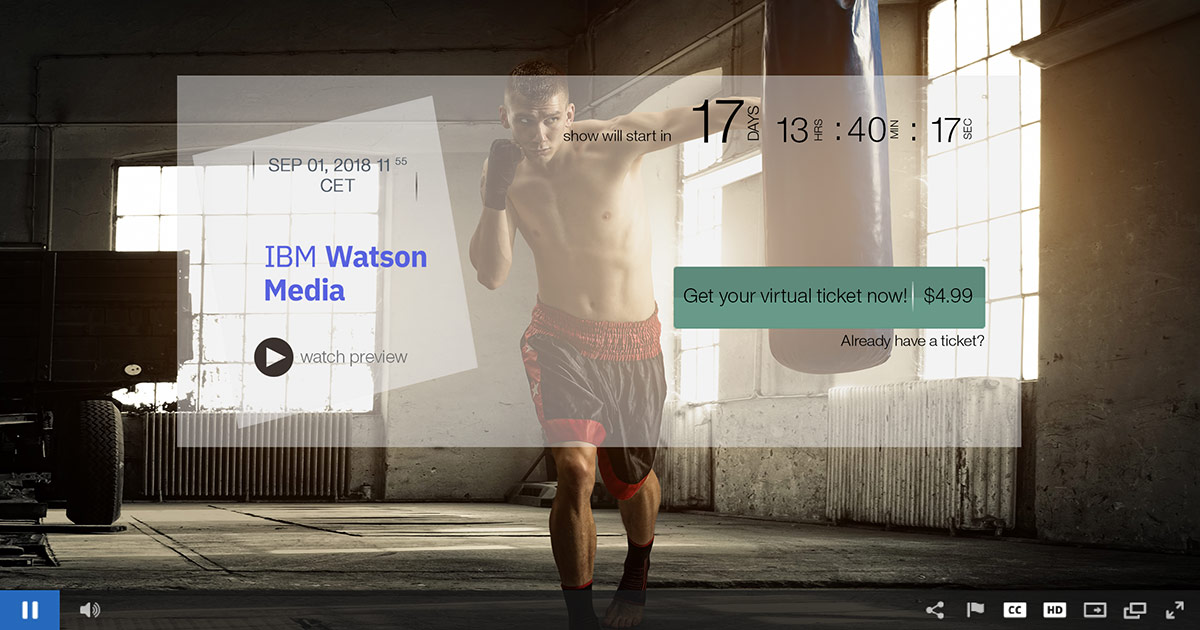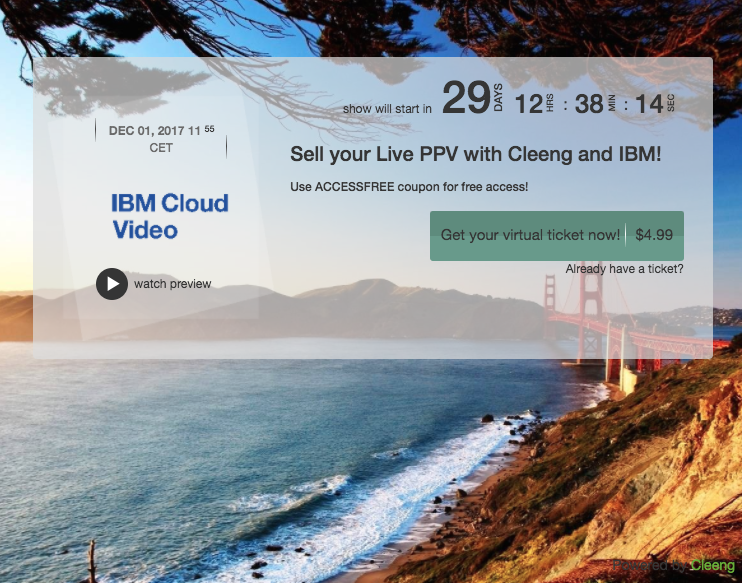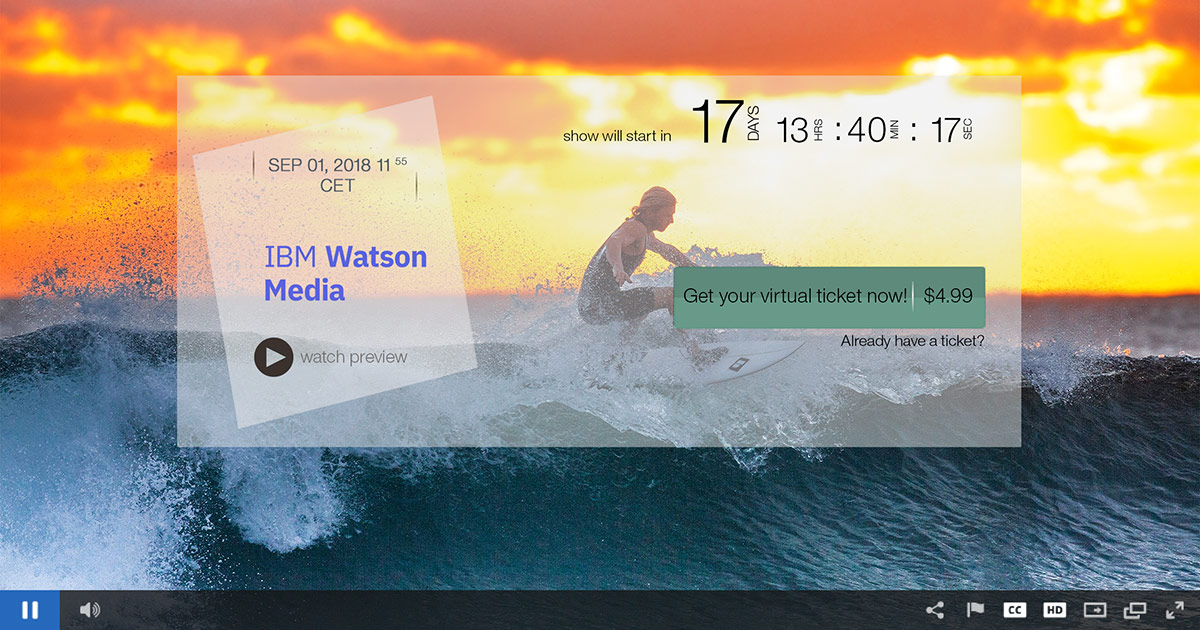
Looking to monetize your video assets or live streams? Interested in pay-per-view (PPV)? Pay-per-view video and paywalls solutions offer content owners a method to create a revenue stream from live broadcasts or on-demand video libraries. This enables organizations to sell their content to viewers, having them pay to access content.
This article describes this process, talks about adding a paywall to your content, strategies and use cases for pay-per-view.
Want additional strategies on video monetization and also methods to reduce churn, increasing predictable revenue from your content? Also be sure to register for our How to Monetize Videos & Reduce Subscriber Churn webinar.
- What is a paywall?
- Adding a paywall to your video content
- Pay-per-view video versus video advertising
- Marketing your monetized live content
- Pay-per-view video use cases
What is a paywall?
A paywall is used to gate premium content, requiring an exchange of money before the content can be accessed. This can be a single payment to access a single asset, or a payment to unlock a catalogue or series of content.
Paywalls can be used to gate any type of asset, from research papers to live video streams. Access can also either be indefinite or for a limited time, with the latter most often being the case. For video assets, this paywall can be located inside the actual video player, managing not just access but containing the payment process as well.
Adding a paywall to your video content
 Utilizing Cleeng with IBM Watson Media is a method to quickly attach a paywall to video assets, be they live or on-demand. The concept includes a quick time-to-market approach, with the ability to have the paywall ready in minutes.
Utilizing Cleeng with IBM Watson Media is a method to quickly attach a paywall to video assets, be they live or on-demand. The concept includes a quick time-to-market approach, with the ability to have the paywall ready in minutes.
The look of the paywall can be customized. It can be outfitted with things like stating the start time, a countdown clock until it begins, a preview and naturally the checkout process. Elements like the logo, background and even colors of the buttons can all be tweaked to match a brand.
In relation to the countdown, after purchase, a user can select inside the paywall to add this to a calendar as well. Support includes for Apple Calendar, Google calendar, Outlook and Yahoo.
Additional options are available for monetizing through Cleeng, including promotional codes and social sharing to allow others to offer discounts as well. It also enables pre-orders as well, an important component for live streams to get a gauge of the audience before the event starts.
User accounts, used to purchase, can be tied to Facebook accounts, Google accounts or email addresses. This not only simplifies the purchase process, but enables users a method to later login and access content they purchased. For example, someone who bought through their Facebook account and who elected not to logout of Facebook would be recognized next time they engage with the paywall, giving them the option to jump in and watch the content. As part of this process, a transactional email is also sent to the user for proof of purchase.
A live demo of using Cleeng and IBM Watson Media is accessible here.
For more information on restricting content, to lock it down for the paywall, watch this Earn Revenue with Pay-Per-View Video archived webinar that includes a demonstration from Cleeng.

Pay-per-view video versus video advertising
The idea of earning money from online video is often associated with generating money from video advertisements. Since July 1941, advertising has funded and powered a lot of television programing. This has created a model that online broadcasters are eager to recreate. Viewers can often be more receptive to this approach as well, preferring to exchange some of their personal time over directly parting with their money.
However, there are many scenarios where pay-per-view can be a more appealing option for a content owner. This includes scenarios where you are dealing with a small or very niche audience. The reason for this is that advertising favors having large, predictable audience sizes. Pay-per-view on the other hand can generate revenue from much smaller audiences.
Now video advertising works on the basics of CPM, which is cost per thousand of impressions (the “M” comes from the roman numeral for a thousand). The CPM you get for a video ad can range pretty dramatically. A report from Tubular Insights had the CPM range for YouTube’s partner program at anywhere from $0.30 to $2.50, while an All Things Digital report cited this as $2.50 to $10.00 but with an asterisk that publishers monetizing from their own site could earn as high as $20 per CPM. As a result of this variance, the level of viewership required for each to be successful will vary drastically.
For example, a broadcast that attracts 3,000 viewers could generate anywhere from $0.90 to $60.00 with video ads using the numbers above. At a price point of $4.99 per pay-per-view, though, it would take just one buy to beat the lowest level and around 12 buys to match the upper limit. If your content has less than 1,000 viewers, than pay-per-view really shines as an oppurtinity to generate revenue from a small audience. Certain types of monetized content, like education based seminars, can really command larger ticket prices as well.
Note: this is not to discount the effectiveness of ads, but to demonstrate the ability for pay-per-view revenue to quickly add up.
Marketing your monetized live event
As noted in this Earn Revenue with Pay-Per-View Video webinar, it’s suggested to plan for at least 6 weeks of promotion and marketing for your live event. This is to create awareness for your live stream and also to validate the purchase. Being a live event, looking at reviews or fan comments is not an option given that the content hasn’t occurred yet. So part of the promotion strategy should be spent on building up the value of what the content will include. A good strategy here can be a preview video, either something related, a personality involved giving a public message to attend or setup footage that can help build excitement and diminish any second thoughts about the event.

Pay-per-view video use cases
While any content could theoretically be sold over pay-per-view, certain content types thrive more than others. Much of this can come from the realization that content doesn’t exist in a vacuum. It is competing directly or indirectly with other video content as well. For example, if one is selling an introduction to HTML video course, it might be hard to be successful if a viewer can alternatively search and find free videos that do the same thing. Keeping this in mind, here are content types that lend themselves to pay-per-view more readily.
Sports content
The poster child for pay-per-view, sports video content is enticing enough to perform very well when sold. On the live streaming side, it can tap into the desire to watch content in the moment. There is a huge difference between seeing that winning play being done live versus hearing after the fact that someone’s favorite team won and made an amazing play. This also makes it possible to create unique content easily as well. For example, selling content related to a high school or college game that would otherwise be unavailable. The only aspect to note is that a bulk of the sales will come through for the live broadcast. While sales can still come through for on-demand content, it’s less likely to be as ever green as some of the other use cases.
Education and workshop content
This type of content can be really successful and can command very high ticket prices for access. The key is that the video is unique or that the speaker is enough of an expert to have a following or seen as valuable to learn from him versus alternatives. Content should be checked against free alternatives. Sometimes very niche material really excels in this category, due to the lack of other options.
Conferences
Trade shows and conferences can attract large audiences. It’s a good platform for thought leader speeches, roundtables and other content that those in the same industry would find valuable. By streaming and selling this content, trade shows can broaden their audiences and open new revenue channels, tapping into those who otherwise would not physically attend or catering to those who were physically turned away from sold out venues.
Entertainment content
From music concerts to scripted programs, video that falls under entertainment can be a successful pay-per-view source. The only dilemma here is competition. A lot of video content can be labeled as entertainment focused, and so comparable content that is being made available for free can endanger the viability of pay-per-view content in this category. A common pitfall can also be trying to build an audience from pay-per-view content. Generally it’s better to give viewers a free episode, free season or some type of content that is available to build interest for the paid material.
Spiritual content
This content can often border on education, although with a faith or spiritual based direction. This can be used to tap into local communities, from those who are apart of them, or provide remote alternatives for those not able to participate at a physical location. Do note, though, that donations are generally more common for this type of content opposed to outright paywalls.
Summary
Pay-per-view can be a great method to monetize video content, and a compelling alternative to video advertising. Through using Cleeng and IBM Watson Media, content owners also have flexibility to quickly launch a paywall and start selling while also choosing their own price and promotion strategy, such as coupons and discounts.
For those who prefer a video version of this article, check out our Earn Revenue with Pay-Per-View Video. Although branded as Ustream, the webinar is also valid for IBM Watson Media.
To learn more about how IBM and Cleeng work together, below is a video case study that examines this.